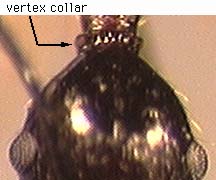

Formicidae, Hymenoptera, Insecta, Arthropoda, Animalia
|
|
|
Range
Guatemala to Panama. Costa Rica: Atlantic slope from sea level to 1100m; one record from 700m on Osa Peninsula.
Identification
Minor worker: head length 0.85mm, head width 0.63mm, scape length 1.33mm, Webers length 1.18mm (n=1). Head with pronounced vertex collar; promesonotal and metanotal grooves well impressed; propodeal spines very long; sculpture on face varying from almost entirely smooth and shining to patchily foveolate; sculpture on pronotum and first gastral tergum similarly variable, from almost entirely smooth and shining to irregularly foveolate.
Major worker: head length 1.54mm, head width 1.40mm, scape length 1.26mm (n=1).
This species (or species complex) shows a common pattern of being darker at higher elevations (see comments on this phenomenon). It also exhibits spatial variation in the pilosity of the major worker head. Collections from sea level to about 600m on the Atlantic slope are yellow, and the major worker has the sides of head with abundant erect setae. Collections from higher elevations in Braulio Carrillo National Park are dark brown, and the major worker continues to have the sides of head with abundant erect setae. Collections from the Penas Blancas Valley are dark brown, and the major worker has the sides of head with sparse, appressed setae.
Natural History
fiorii inhabits mature wet forest understory. It makes hemispherical carton nests under individual leaves of palms, aroids, and other large-leaved plants. The nests are on the order of 10cm across, and usually at head height or lower. Colonies appear to be monogynous and with a single nest (not polydomous). At La Selva, fiorii is part of a set of ant species that build nests under individual live leaves, the others being: Apterostigma collare, Paratrechina caeciliae, Tapinoma inrectum, Wasmannia sp., and Dendromyrmex spp. (Black 1987).
Observations at La Selva and Penas Blancas suggest large changes in abundance of fiorii. There are times when fiorii appears to be very abundant in the forest (the nests are relatively conspicuous), and other times when they seem to be almost totally absent. It is unknown whether changes reflect regular patterns of movement associated with seasonality, or long-term declines in abundance.
Selected Records
Tortuguero: Wet forest. Carton nest on undersurface of palm leaf at leaf tip. Nest about the size of a flattened tennis ball, contained alates of both sexes, hundreds of workers.
Braulio Carrillo National Park (500m): Primary wet forest. Carton nest under broad leaf of understory shrub or sapling, under 1m high. Nest with workers, soldiers, one colony queen.
Braulio Carrillo National Park (Bajo la Hondura): workers at bait on vegetation.
Braulio Carrillo National Park (950m): mature wet forest; carton nest on undersurface of single leaf on small understory sapling; entire nest contents collected; the queen was very furtive, and when I had picked through the upper 2/3 of the nest she quickly ran under the leaf, unattended, and tried to escape.
Penas Blancas Valley: mature wet forest; nest being raided by Simopelta. The raided nest was a pendant agglomeration of chambered humus-like material on two strap-shaped fern leaves. The nest hung about 1.5m above a stream. The colony had completely abandoned the nest or been taken in the raid. All that remained were some brood, 1 callow worker, a male, and an alate queen that was cloistered in an inner chamber, probably as yet unnoticed by the Simopelta. An aggregation of Pheidole workers was observed on nearby vegetation.
Penas Blancas Valley: mature wet forest; carton nest on underside of palm leaf.
Penas Blancas Valley: mature wet forest; carton nest under leaf of Cyclanthaceae.
Literature Cited
Black, R. W. 1987. The biology of leaf nesting ants in a tropical wet forest. Biotropica 19:319-325.
John T. Longino, The Evergreen State College, Olympia WA 98505 USA. longinoj@evergreen.edu
Stefan Cover, Museum of Comparative Zoology, Harvard University, Cambridge MA 02138 USA. scover@oeb.harvard.edu